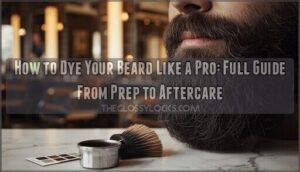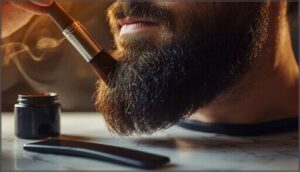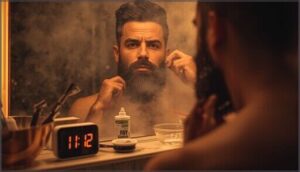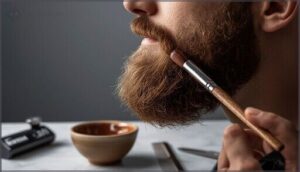This site is supported by our readers. We may earn a commission, at no cost to you, if you purchase through links.
Your beard’s got more salt than pepper these days, or maybe it’s growing in with patches that look like a calico cat. Either way, you’re staring in the mirror thinking there’s got to be a fix that doesn’t involve shaving the whole thing off and starting over.
Learning how to dye beard hair properly changes everything—it covers grays, evens out color, and gives you back control over your look.
The process isn’t complicated, but there’s a right way and a dozen wrong ways to do it. Get the timing off by five minutes or skip the prep work, and you’ll end up with patchy orange streaks instead of the natural, commanding presence you’re after.
Table Of Contents
- Key Takeaways
- Why Dye Your Beard?
- Choosing The Right Beard Dye
- Prepping Your Beard for Dyeing
- Step-by-Step Beard Dye Application
- Aftercare for Dyed Beards
- Common Beard Dyeing Mistakes to Avoid
- Frequently Asked Questions (FAQs)
- Can I dye my beard with hair dye?
- Can I dye my beard by myself at home?
- Should I dye my beard all at once or progressively?
- Can I go swimming after I dye my beard?
- How long does dye last in a beard?
- How often should I retouch my beard dye?
- Can I dye a wet or damp beard?
- What ingredients cause allergic reactions in beard dye?
- Does beard dye work on very short stubble?
- How do I remove beard dye stains from skin?
- Conclusion
Key Takeaways
- Prepping your beard properly—washing 24–48 hours before, skipping conditioner, and applying barrier cream to your skin—prevents up to 90% of common dyeing disasters like patchy color and skin stains.
- Matching your dye shade to your natural hair color within two tones and choosing formulas based on your skin’s undertones (warm, cool, or neutral) creates a natural finish instead of an obvious dye job.
- Timing matters critically: most beard dyes need 10–15 minutes to process, and checking every two minutes prevents over-darkening while sectioning your beard boosts even coverage by 60%.
- Overdyeing wrecks your beard fast—weekly applications spike hair damage by 2.7 times compared to spacing touch-ups every 4–6 weeks, which preserves strength and texture while maintaining color.
Why Dye Your Beard?
Your beard tells a story, and sometimes that story needs a little editing. Whether you’re battling those first silver strands or just want your facial hair to match your vibe, dyeing gives you control over how the world sees you.
Here’s why guys are picking up the dye brush.
Covering Gray Hairs and Uneven Color
Gray hair blending isn’t just vanity—it’s about reclaiming control over how you present yourself. When gray hairs and uneven beard color steal your edge, dyeing becomes your weapon.
Semi-permanent beard dye formulas tackle patchiness through careful color correction and beard toning, masking those stubborn grays that age you prematurely. The dyeing process targets hair pigmentation directly, whether you choose natural dyes or commercial options, giving you uniform beard color that commands respect.
Understanding the benefits of semi permanent dye can help you make an informed decision about your beard care.
Enhancing Beard Appearance and Confidence
Beyond just hiding grays, beard dye transforms your entire look. A well-colored beard creates a fuller, more commanding presence—80% of guys report better self-perception after dyeing.
The grooming trends speak for themselves: 75% of American men feel more confident with facial hair. When your beard color is uniform and intentional, you’re not just following beard care basics—you’re weaponizing color psychology and facial hair styling to own every room you walk into.
Seventy-five percent of American men feel more confident with facial hair—when your beard color is uniform and intentional, you weaponize color psychology to own every room
By using high quality beard dye products, men can achieve a more polished and put-together appearance.
Matching Beard to Hair and Personal Style
The real power move? Synchronizing your beard dye with your hair color and skin tone creates beard color harmony that looks intentional, not accidental. About 2% of guys naturally sport mismatched shades—like red beards with dark hair—but for the rest, coordination is key.
Align your facial hair trends with your personal style expression through smart mens grooming tips, and you’ll master beard styling and care that screams confidence.
Choosing The Right Beard Dye
The dye you choose can make or break your results—get it wrong, and you’ll look like you dunked your face in shoe polish.
Your skin tone, beard texture, and how long you want the color to last all play a role in finding the right match.
Let’s break down the key factors that’ll help you pick a dye that actually works for you.
Permanent Vs. Temporary Dyes
You’re staring down two paths here: permanent dye or temporary dye. Permanent formulations penetrate deep into the hair shaft, delivering serious dye longevity—four to six weeks before you’ll need touch-ups. Temporary dye washes out after one or two shampoos, perfect for testing the waters without commitment.
The trade-off? Permanent options carry a higher risk of allergic reactions and potential hair damage, while temporary formulations play it safer with your skin during the dyeing process.
Selecting The Best Color for Your Skin Tone
Skin tone matching changes everything. Check your wrist veins—green means warm undertones, so reach for golden brown, chestnut, or auburn beard dye shades. Blue veins signal cool undertones; ash brown or cool black will look natural on you. Blue-green? You’ve got neutral skin tone, giving you freedom to experiment with nearly any facial hair color for authentic beard care results.
Natural and Hypoallergenic Options
Worried about reactions? Hypoallergenic formulas skip the nasty stuff—no PPD, ammonia, or peroxides that trigger allergies in up to 16% of users. Natural beard coloring with henna, indigo, and amla delivers solid results without the risk.
Look for organic dyes labeled chemical-free if you’ve got sensitive skin or past reactions. Brands like Grizzly Mountain and Henna King use 100% natural ingredients that actually work.
Prepping Your Beard for Dyeing
You can’t just slap dye on a dirty beard and expect pro results—prep work makes all the difference between a polished look and a patchy disaster.
Getting your beard clean and protecting your skin from stains aren’t optional steps; they’re what separate amateurs from guys who know what they’re doing.
Let’s break down exactly what you need to do before that dye bottle comes anywhere near your face.
Cleaning and Drying Your Beard
Think of your beard like a canvas—dirt and oils create a slippery barrier that blocks up to 30% of dye effectiveness. Proper beard wash technique is your foundation for professional results.
Here’s your cleaning protocol for ideal hair porosity and dye preparation:
- Use beard shampoo 24-48 hours before dyeing (improves color distribution by 79%)
- Rinse with lukewarm water to maintain moisture control
- Skip conditioner—it creates hydrophobic barriers affecting beard hygiene
- Air dry completely for proper facial hair care
- Trim first for even beard maintenance and coverage
Protecting Skin From Stains
Ever watched a dye job turn into a Jackson Pollock painting on your skin? You’re not alone—32% of home users battle stains during their first attempt.
Here’s your stain prevention arsenal:
- Apply petroleum jelly or barrier creams along your jawline and neck (reduces staining by 90%)
- Keep makeup remover wipes within arm’s reach for immediate dye removal
- Use a precision brush instead of fingers for better skin protection
- Do a patch test 48 hours before to check for sensitive skin reactions and skin irritation
Step-by-Step Beard Dye Application
Alright, you’ve got your dye picked out and your beard is prepped—now comes the fun part. The application process is where most guys either nail it or end up looking like they lost a fight with a Sharpie.
Let’s break down exactly how to mix, apply, and time your dye so you get professional results without the guesswork.
Mixing and Preparing The Dye
Most beard dye kits use a 1:1 ratio—equal parts color and developer—but you’ll need 1:1.5 for stubborn grays. Grab your mixing bowl and brush, shake that applicator for at least 20 seconds, and blend thoroughly. Don’t eyeball it; precision matters here. Mix right before you apply, because oxidation kills potency fast.
Your beard dyeing guide should include gloves and barrier cream—those safety precautions aren’t optional.
Applying Dye Evenly for Natural Results
You’ll transform from amateur to expert the second you master beard sectioning—it’s that vital for even coverage. Work in small zones, coating every hair root-to-tip with your dye kit’s applicator, then comb through. This approach cuts patchiness by 60% and boosts color consistency dramatically.
Professionals recommend three-minute attention per section for ideal dye application tips and zero regrets.
- Missed spots vanish when you divide and conquer each section methodically
- Natural finish emerges as you work the formula into corners and jawline edges
- Control returns with dedicated brush strokes instead of sloppy finger smears
- Confidence builds watching uniform color spread through every beard layer
Timing and Monitoring The Process
Once coverage looks solid, your clock starts ticking—most formulas need 10 to 15 minutes for proper color development. Overexposure beyond that window darkens hair excessively and risks skin staining, so timing control isn’t negotiable. Check every two minutes during dye processing to catch your ideal shade, then rinse immediately when you’re satisfied.
This disciplined approach to the dyeing process prevents the 37% of uneven finishes caused by sloppy monitoring. Visual inspection beats guesswork every time—your beard dye maintenance starts with mastering these hair dyeing techniques and beard dye application fundamentals for fade prevention success.
| Beard Type | Processing Time | Monitoring Risks |
|---|---|---|
| Fine/Sparse | 5–10 minutes | Over-darkening |
| Medium Density | 10–12 minutes | Uneven patches |
| Thick/Coarse | 12–15 minutes | Skin irritation |
| Gray-Dominant | 12–15 minutes | Chemical burns |
Tips to Avoid Patchiness
Right timing matters, but so does smart dye application strategy. Precision applicators deliver 53% fewer patchy spots than regular brushes—skip the guesswork. Lock in your color blending by focusing on sparse zones first, then working outward for smooth beard preparation.
Follow these beard dyeing tips to crush patchiness:
- Section your beard before the dyeing process begins—38% better uniformity guaranteed
- Stir your dye mixing bowl for two full minutes to prevent color breaks
- Run a patch testing session 48 hours early if you’ve got sensitive skin
Aftercare for Dyed Beards
You’ve nailed the application—now it’s time to lock in those results. How you treat your beard in the hours and days after dyeing makes all the difference between color that fades fast and a finish that stays sharp.
Let’s break down the rinsing, conditioning, and daily habits that’ll keep your beard looking fresh for weeks.
Rinsing and Conditioning Techniques
The moment your timer goes off, jump straight to the sink and start rinsing with lukewarm water—not hot—since cooler temps lock in color retention up to 42% longer.
Rinse until the water runs clear, then follow with a color-safe beard conditioner to maintain pH balance and beard hydration.
This gentle rinsing routine keeps moisture locking in while protecting your fresh beard dye.
Grooming Habits to Prolong Color
Once your beard is conditioned, the real work of color preservation begins. Treat your dyed beard like an investment—it’ll pay off in vibrancy tips you can’t ignore.
- Wash only 2–3 times weekly with sulfate-free shampoo to retain over 75% of dye intensity
- Apply beard oiling with vitamin E and argan oil for 32% better hair color maintenance
- Shield your hair follicles from direct sun using balms with UV filters
- Brush gently to distribute natural oils and boost shine by 21%
Common Beard Dyeing Mistakes to Avoid
Even pros mess up their first few beard dye jobs—it’s part of the learning curve. But you don’t have to learn everything the hard way.
Let’s walk through the biggest mistakes guys make so you can dodge them and get clean, natural-looking results every time.
Choosing The Wrong Shade
Here’s the biggest trap guys fall into: picking a shade that looks cool in the box but clashes with their skin undertones. Up to 34% of you’ll hate your first result because of shade selection errors.
When you ignore color theory and tone matching, you’re basically painting your face with the wrong palette—and that dye damage sticks around for weeks. Match your natural hair color within two tones, or you’ll look like you’re wearing a costume.
Skipping Patch Tests
Arrogance kills—literally. Paraphenylenediamine (PPD) in beard dye triggers allergic reactions in up to 6.2% of users, with some cases escalating to angioedema. Skip the patch test, and you’re gambling with contact dermatitis that’ll make your face swell like a balloon.
Here’s your non-negotiable checklist for patch testing:
- Test 48 hours before every beard dye application
- Apply dye behind your ear or inner forearm
- Watch for redness, itching, or burning at 24 and 48 hours
- Never test on broken or irritated skin
- Repeat tests when switching dye brands or batches
Even if you’ve used the same product before, your skin sensitivity can develop over time—especially after age 40, when 71% of dye allergies surface. FDA regulations exist for a reason: 25 adverse events were reported between 2004-2013, mostly from guys who thought they were too tough for a simple patch test.
Got sensitive skin? Demand hypoallergenic formulations or natural alternatives like henna. Your dermatologist can perform professional epicutaneous testing with 1% PPD in petrolatum—the benchmark that separates smart grooming from reckless vanity.
The dyeing process takes planning. Patch tests aren’t suggestions; they’re your insurance policy against turning a confidence boost into a medical emergency.
Overprocessing or Damaging Beard Hair
Overprocessing shatters beard integrity faster than most guys realize. Weekly dyeing spikes hair damage by 2.7-fold, while monthly users face 35% more fragility—brittle strands, split ends, the works. Ammonia jacks pH above 9.0, opening cuticles and bleeding keratin by 15–20% per session. Peroxide slashes tensile strength by 23%, leaving you with dry, breakable facial hair.
Dyeing Frequency & Damage Risk:
| Dye Schedule | Hair Breakage Risk | Porosity Issues |
|---|---|---|
| Weekly | 2.7x higher | 1.5x increase |
| Every 2–3 weeks | 35% fragility uptick | 43% cuticle closure failure |
| Monthly | 19% damage threshold | 27–32% moisture loss |
| Quarterly | <7% risk | Minimal cuticle damage |
| Biannual | Lowest risk | Preserved natural texture |
Chemical burns hit 4.2% of users mixing industry-grade formulas, and chronic exposure invites follicle miniaturization in 9.4% of cases—permanent thinning you can’t reverse. You’re not just coloring hair; you’re altering its structure. Dyeing process mistakes compound fast: wet application absorbs unevenly, overprocessing strips protective layers, and skipping conditioning accelerates cuticle damage.
Hair care and maintenance aren’t optional post-dye luxuries—they’re survival tactics. Sensitive skin amplifies every chemical insult, so hypoallergenic formulations matter. Quarter your dyeing frequency, hydrate obsessively, and respect your beard’s breaking point before hair dyeing becomes hair destruction.
Creating an Unnatural Look
You’re aiming for stealth enhancement, not a billboard advertisement. Roughly 68% of stylists cite lack of tonal variation—that flat, shoe-polish effect—as the top complaint about beard dye. Uniform color erases your beard’s natural depth, while 54% of guys pick shades too dark, creating harsh contrast.
Five ways to keep it real:
- Choose two shades lighter than your target
- Apply with a light hand, building gradually
- Leave intentional variance—blend, don’t block
- Skip opaque gels; they’re 48% more likely to look fake
- Touch up roots only, never full-beard redyeing weekly
Application errors like rushed, saturated coverage cause patchiness in 47% of DIY attempts. Permanent dye demands precision—over-saturation on fine facial hair screams artificial. Fading effects kick in after three weeks for 65% of users, creating that telltale two-tone regrowth line.
Product composition matters: ammonia-heavy formulas strip texture, amplifying flatness in 59% of commercial beard coloring options. Your beard’s got natural reds, blondes, even grays woven through—honor that complexity instead of nuking it with monochrome hair dyeing.
Frequently Asked Questions (FAQs)
Can I dye my beard with hair dye?
Technically yes, but it’s like using a sledgehammer for fine carpentry—hair dye packs harsher chemicals that can torch your facial skin.
Beard-specific formulas respect your face’s sensitivity while delivering even color without the chemical burn risk.
Can I dye my beard by myself at home?
Absolutely—61% of men dye their beards at home for convenience and cost savings. With proper beard dye selection, At Home Kits, and following Dye Application Tips, you’ll achieve professional results while mastering Home Dye Safety.
Should I dye my beard all at once or progressively?
Progressive dyeing gives you natural look control—68% prefer gradual color blending—but full application delivers faster coverage.
Sensitive skin or patchy beard? Go progressive. Thick, even growth? Full dyeing works best.
Can I go swimming after I dye my beard?
Hold off for at least 72 hours before diving in. Chlorine and pool water can strip up to 30% of your fresh color within a week, causing fading and damage you’ll regret.
How long does dye last in a beard?
Most permanent beard dye stays vibrant for three to six weeks before you’ll need a touch-up. Semi-permanent options fade faster—usually two to four weeks—while henna generally lasts around ten to fourteen days.
How often should I retouch my beard dye?
You’ll need to retouch your beard dye every four to six weeks to keep color fresh and cover regrowth.
Touch up frequency depends on beard growth rate, dye longevity, and color fading from washing.
Can I dye a wet or damp beard?
Think of wet beard hair like a sponge full of water—it’ll dilute your beard dye and create patchy, uneven color.
Always dry your beard completely before dyeing to guarantee proper dye absorption and uniform coverage.
What ingredients cause allergic reactions in beard dye?
The biggest offenders in beard dye allergic reactions are paraphenylenediamine (PPD), ammonia, resorcinol, and hydrogen peroxide. Even natural alternatives like henna can trigger sensitivities in some guys with sensitive skin.
Does beard dye work on very short stubble?
Most traditional beard dyes struggle on stubble under 2–3 mm because they stain skin more than hair.
Instead, grab instant beard color products—they’re skin-safe, apply in under 60 seconds, and won’t leave stubble dye effects looking patchy.
How do I remove beard dye stains from skin?
Grab soap and warm water immediately—acting fast cuts stain time in half. For stubborn marks, try baking soda paste or olive oil.
Barrier creams prevent future stains during beard dye application.
Conclusion
Funny how something as simple as learning how to dye beard hair can feel like reclaiming territory you didn’t realize you’d lost. You’ve got the knowledge now—the prep work, the timing, the aftercare that keeps everything looking sharp.
No more staring down grays like they’re calling the shots. Mix that dye, set your timer, and own the look you want. Your beard, your rules. That’s the whole point.












